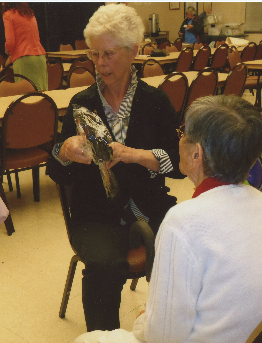
I spent my Sunday afternoon with 15 delightful women, most over the age of 80. I had been asked to speak on the importance of muscle strength as one gets older. The audience was attentive. I had handouts in large print, big photos - almost posters - to pass around and a portable microphone. They appreciated all of it. After the introduction, I reviewed the value of muscle strength training for older persons. Good review for this group.
Then I started with muscle strength and posture – it was a palpable response. I have an uncanny ability to alter my posture to exemplify altered function. When I “stooped” the group leaned forward, nodded their heads and some exclaimed under their breath “why, that’s me”, or “that’s how I look”. I demonstrated the muscles that control that part of our posture and immediately the attendees felt they’d gotten their monies worth (the session was free!).
There was more to the seminar: a self-assessment of functional decline to use when visiting their MD; physical assessment related to specific strength exercises; and tips on strength training itself. One of the first to break the ice asked “but my doctor told me to take it easy”. “How long ago?” I asked. “Years ago”.
Frankly the person asking the question didn't know how to interpret what was easy and what wasn't. Would they hurt themselves, do damage, set back their functional level, get sicker, or need more treatment? Better yet, could they self-determine what was their threshold for: motion, exercise, and amount of resistance?
With demonstration, feedback and guidance several of the women experimented with their ability to perform a movement with and without resistance. They were able to detect their limits and what they could do on their own. It took a few minutes.
We clinicians do not know how people will interpret our cautionary instructions. One of my elderly patients was told to keep her head straight due to extensive degenerative changes in her cervical spine. She heard “keep your neck stiff” and she complied. This resulted in reduction in head turning, muscular tightness and lingering pain. She thought it came with the territory.
We can not, nor should not, abandon the use of precautions. We can give simple tips. We can explain that this instruction should be reviewed. This is one of the times I recommend that a physical therapist’s input should be sought.

No comments:
Post a Comment